#School in Amritsar
Explore tagged Tumblr posts
Text
Best Nursery Schools in Amritsar: Find the Perfect Start for Your Child’s Education
Amritsar, the spiritual and cultural hub of Punjab, is not only known for its religious significance but also for its growing educational landscape. With the increasing emphasis on early childhood education, parents in Amritsar are looking for the best nursery schools to give their children a strong foundation for future learning. Nursery schools play a vital role in the development of a child, nurturing cognitive, emotional, physical, and social skills during their formative years. If you’re looking to provide your child with an ideal start to their education, this guide will help you discover the top nursery schools in Amritsar.
Why Nursery Education is Important The early years of a child's life are critical for cognitive and emotional development. During this period, children learn to socialize, develop basic motor skills, and understand the world around them. A quality nursery school offers an engaging, safe, and stimulating environment where children can explore, create, and learn through play. In addition to building foundational academic skills, nursery schools focus on promoting social interaction, emotional intelligence, and independence.
A good nursery education lays the groundwork for a child’s success in later stages of schooling and beyond. By selecting the right nursery, parents can ensure their child is ready to take on the challenges of formal schooling with confidence.
Key Factors to Consider When Choosing a Nursery School When selecting a nursery school for your child, there are several important factors to consider:
Curriculum and Teaching Methodology Look for a nursery that follows a well-rounded, child-centered curriculum. Play-based learning is essential at this stage as it allows children to explore and learn at their own pace. Schools that offer a mix of structured and unstructured activities are often ideal. Curriculums based on methods like Montessori, Reggio Emilia, or Waldorf are popular choices as they encourage creativity, independent thinking, and emotional development.
Teacher Qualifications and Experience The quality of teaching staff is crucial. Ensure that the teachers are well-trained, experienced, and passionate about working with young children. They should be equipped to understand the individual needs of each child and provide a supportive learning environment.
Teacher-Student Ratio A low teacher-to-student ratio is important in a nursery setting. Smaller class sizes ensure that each child receives more personalized attention, which aids in their learning and emotional growth.
Infrastructure and Facilities The school’s infrastructure should be safe, hygienic, and conducive to learning. Look for schools with well-maintained classrooms, outdoor play areas, and age-appropriate educational toys and materials. Safety features such as secure entrances, proper sanitation, and child-proofing are also vital.
Parental Involvement Schools that encourage parental involvement help create a strong support system for the child’s development. Check if the school conducts parent-teacher meetings or organizes workshops and events that involve families in the learning process.
Reputation and Reviews Before making a final decision, research the school's reputation. Online reviews, word-of-mouth recommendations from other parents, and visiting the school for a firsthand experience can provide insights into the quality of education and the school’s environment.
Top Nursery Schools in Amritsar Here is a list of some of the best nursery schools in Amritsar that offer exceptional early childhood education:
Kangaroo Kids International Preschool Kangaroo Kids is an internationally recognized chain of preschools with a reputation for offering high-quality education. With a strong focus on holistic development, Kangaroo Kids encourages learning through play and exploration. Their curriculum integrates arts, science, math, and language development, all while ensuring that children engage in activities that promote emotional, social, and physical growth. The school maintains a low teacher-student ratio, ensuring personalized attention and a nurturing environment.
Highlights:
Play-based and child-centric curriculum State-of-the-art facilities and safety measures Interactive learning tools and resources Focus on creative development and critical thinking
EuroKids Amritsar EuroKids is one of the most prominent names in early childhood education in India. The school offers a comprehensive curriculum that combines fun with learning, focusing on developing key skills like communication, problem-solving, and social interaction. EuroKids uses activity-based learning that enables children to learn through play, hands-on experiences, and creative activities. The staff is highly trained, and the school maintains an excellent teacher-student ratio to ensure every child’s needs are met.
Highlights:
Fun, engaging, and developmentally appropriate curriculum Strong emphasis on emotional intelligence and social skills Modern infrastructure and age-appropriate toys Regular parent-teacher interactions
Little Einsteins International Preschool Little Einsteins International Preschool is an ideal choice for parents who want a balanced approach to early childhood education. The school uses a blend of Montessori and Playway methodologies, which encourages children to learn through exploration, experimentation, and hands-on activities. Little Einsteins fosters a stimulating environment where children’s curiosity is nurtured, and their individual learning styles are respected. With small class sizes and a highly qualified staff, children receive the attention they need to thrive.
Highlights:
Combination of Montessori and Playway teaching methods Focus on developing creativity and cognitive skills Spacious classrooms with child-safe infrastructure Healthy meals and outdoor playtime
The Cambridge Nursery School The Cambridge Nursery School offers a structured yet flexible curriculum designed to help children build a strong foundation in language, numbers, and social interaction. With an emphasis on both academic and personal development, the school focuses on helping children develop confidence, independence, and a love for learning. The staff at The Cambridge Nursery School are highly trained in child psychology and early childhood education, ensuring that each child receives individual care.
Highlights:
Well-structured curriculum with a focus on both academics and emotional growth Individual attention due to small class sizes Interactive play and learning sessions Safe and welcoming environment
Shemrock Amritsar Shemrock is one of the most well-known preschool chains in India, with a reputation for providing quality education in the early years. The school offers a nurturing environment where children are encouraged to explore and learn through fun, hands-on activities. The curriculum is designed to help children develop essential skills such as communication, social interaction, and motor coordination. Shemrock Amritsar stands out for its caring teachers and strong parent-school partnership.
Highlights:
Focus on all-round development (physical, emotional, intellectual) Innovative learning techniques and hands-on experiences Strong parent-school collaboration Emphasis on hygiene, safety, and cleanliness Conclusion Choosing the right nursery school in Amritsar is a crucial step in laying the foundation for your child's academic and personal growth. Whether you prefer a play-based curriculum, a Montessori approach, or a more traditional learning method, there are several excellent options in Amritsar. Schools like Kangaroo Kids, EuroKids, Little Einsteins, The Cambridge Nursery, and Shemrock are among the best in the city, each offering unique strengths to cater to a variety of learning needs.
When selecting a nursery school, consider factors like the curriculum, teacher qualifications, infrastructure, and reputation to ensure your child receives the best early education possible. Early childhood education is an investment in your child's future, and finding the right school is the first step toward their lifelong success.
0 notes
Text
Education Oasis: Millennium School’s Role in Amritsar
In the heart of Amritsar, a city known for its rich cultural heritage and historical significance, the Millennium School stands as a beacon of educational excellence. As one of the leading CBSE schools in Amritsar, Millennium School has carved a niche for itself by providing holistic education that nurtures the academic, social, and emotional development of its students.
Academic Excellence
Millennium School Amritsar is renowned for its commitment to academic rigor and excellence. The school follows the CBSE curriculum, which is known for its comprehensive and well-structured approach to education. The curriculum is designed to foster critical thinking, creativity, and a love for learning among students. The school’s emphasis on academic excellence is reflected in its consistently outstanding board examination results, making it one of the best CBSE schools in Amritsar.
Holistic Development
Beyond academics, Millennium School places a strong emphasis on the holistic development of its students. The school offers a wide range of co-curricular and extracurricular activities, including sports, arts, music, and drama. These activities provide students with ample opportunities to explore their interests and talents, develop new skills, and build self-confidence. The school believes in nurturing well-rounded individuals who are not only academically proficient but also socially and emotionally intelligent.
Innovative Teaching Methodologies
The Millennium School is at the forefront of adopting innovative teaching methodologies that enhance the learning experience. The school employs modern teaching aids and technology to make learning more interactive and engaging. Smart classrooms, digital libraries, and state-of-the-art laboratories provide students with hands-on learning experiences that stimulate their curiosity and foster a deeper understanding of subjects.
Experienced Faculty
The school boasts a team of highly qualified and experienced faculty members who are dedicated to providing quality education. The teachers at Millennium School are not just educators but also mentors who guide and support students in their academic and personal growth. The faculty’s commitment to continuous professional development ensures that they stay updated with the latest educational trends and best practices.
Student-Centric Approach
At Millennium School, the student is at the center of all educational initiatives. The school follows a student-centric approach that focuses on the individual needs and learning styles of each student. Personalized attention, regular assessments, and constructive feedback help in identifying and addressing the unique strengths and areas for improvement of every student. This approach ensures that each student reaches their full potential.
Community Engagement and Values
Millennium School also emphasizes the importance of community engagement and inculcating strong moral values in students. The school organizes various community service projects and awareness campaigns that encourage students to contribute positively to society. Values such as respect, empathy, integrity, and responsibility are integrated into the school culture, shaping students into responsible and compassionate citizens.
Parental Involvement
Recognizing the crucial role of parents in a child’s education, Millennium School fosters strong partnerships with parents. Regular parent-teacher meetings, workshops, and interactive sessions keep parents informed and involved in their child’s educational journey. This collaborative approach ensures a supportive learning environment both at school and at home.
Conclusion
In conclusion, Millennium School Amritsar stands out as an education oasis in the bustling city of Amritsar. With its unwavering commitment to academic excellence, holistic development, and innovative teaching methodologies, the school has established itself as one of the best CBSE schools in Amritsar. By nurturing well-rounded individuals and instilling strong values, Millennium School is shaping the future leaders of tomorrow. Its role in the educational landscape of Amritsar is truly commendable, making it a preferred choice for parents seeking quality education for their children.
#best cbse school in Amritsar#Best School in Amritsar#Amritsar Best School#best School inPatiala#Best School in Kurukshetra#Best Cbse School in Bathinda#Best Cbse School in Indore#MIllennium Learning School in Amritsar
0 notes
Text
Dashmesh International School Amritsar
A prominent school in Amritsar, Dashmesh International School is committed to giving kids an advanced education and all-around growth. The school has a strong focus on academic performance and provides an extensive education that meets each student's unique requirements and promotes their intellectual, emotional, and social development. The school's exceptionally skilled and knowledgeable faculty members guarantee a supportive and interesting learning environment.
Located in the culturally rich city of Amritsar, Dashmesh International School combines modern teaching methodologies with traditional values. In order to facilitate a well-rounded education, the school has modern amenities like fully prepared classrooms, a library, a science lab, and sports facilities. The school supports outside activities and events as a way to develop students' abilities.
If you're seeking an educational institution that prioritizes character development alongside academic success, Dashmesh International School Amritsar is the ideal choice. Prepare your child for a bright and promising future with a foundation built on knowledge, values, and personal growth.
1 note
·
View note
Text
CBSE Schools in Amritsar
Find the best CBSE schools in Amritsar, know the admission procedure, and fee structure, and read reviews. Connect with other parents and students in your area Read More:
#Best CBSE Schools in Amritsar#CBSE school Amritsar admission procedure#list of CBSE Schools in Amritsar
0 notes
Text
Mycroft Holmes. Again.
I guess this is my way of saying I'm back on my MTP bullshit? And that I am too far through a new fic for my school final to not be finished yet, but priorities. This would go where prologues usually go, if I actually end up finishing and posting this.
When he was a young child, sometime between the death of their mother and the beginning of his dubiously storied career at Harrow, Sherlock had come into possession of a pair of magnets. Mycroft could not remember the year, exactly, but he could remember the singleminded focus with which his younger brother set about discovering all of the magnets’ secrets. They had struck Sherlock as something arcane, bordering on magical, no matter how many times Mycroft had explained to him how they worked; Sherly had spent hours at a time determining how strongly the magnets would seek each other through a selection of materials at a variety of thicknesses.
There would be a little crease that had appeared between his brows every time the magnets failed to find each other, and the only word Mycroft had had for it was disappointment. It had made his chest twinge, young as he himself was at the time. There was quite possibly nothing to be done about the strength of Sherlock’s magnets, but Mycroft has spent an entire night in their father’s study, searching through his books for some way to make it better. He’d read in detail about electromagnetic experiments, and had, for the first and only time, made the mistake of telling Sherlock something without supervising the effects it had on him, and, well. Despite the maid’s claims, Sherlock had not burned the house down, only scorched the drapery in the sitting room. Very heavily scorched, sure, with some damage to the crown moulding, but the house stood. So, too, did the point.
From that day, Mycroft Holmes had thought he’d developed something of a sixth sense for when magnetism might lead to trouble. And yet, when he picked up the dossier on the British Indian Army’s most recent exploit in Amritsar, he hadn’t even felt a twinge.
#yuukoku no moriarty#moriarty the patriot#mtp headcanon#mycroft holmes#fanfic writing#fanfic#sherlock holmes#albert james moriarty#mtp fanart#mtp sherlock#yuumori
27 notes
·
View notes
Text
Akshay Kumar's Journey to Stardom
Akshay Kumar's journey to stardom is a captivating tale of resilience, talent, and sheer determination. Born Rajiv Hari Om Bhatia on September 9, 1967, in Amritsar, Punjab, India, Kumar initially harbored dreams of becoming a martial arts instructor. However, destiny had other plans for him, leading him down the path to Bollywood fame.

After completing his schooling, Kumar ventured into the world of modeling before making his acting debut in the late 1980s. His early foray into Bollywood was modest, with minor roles that failed to make a significant impact. However, Kumar's breakthrough came in 1992 with the action-packed thriller "Khiladi," which not only catapulted him to stardom but also earned him the moniker "Khiladi Kumar."
With his chiseled physique, impeccable comic timing, and versatility as an actor, Kumar soon became a force to be reckoned with in the Indian film industry. Throughout the 1990s and early 2000s, he delivered a string of successful films, including "Mohra," "Main Khiladi Tu Anari," and "Hera Pheri," solidifying his status as a bona fide superstar.
Kumar's appeal transcends genres, as he seamlessly transitions from action-packed roles to light-hearted comedies and socially relevant dramas. His ability to connect with audiences across demographics has made him one of the most bankable stars in Bollywood.
Beyond his acting prowess, Kumar is also known for his philanthropic endeavors. He has lent his support to various causes, including initiatives aimed at supporting Indian soldiers and promoting health and hygiene in rural communities.
Today, Akshay Kumar stands as a towering figure in Bollywood, with a career spanning decades and a legacy that continues to inspire aspiring actors and fans alike.
For more detailed information about Akshay Kumar's journey to stardom, you can visit IMDb's biography page, which provides comprehensive insights into his life and career milestones.
2 notes
·
View notes
Text
Online National Level Debate Competition
Vansh Shiv Neelan from Amity University and Sanchit Singh Bhandari from KCCILHE together won Online National Level Debate Competition on the theme “DO WE REQUIRE CENSORSHIP IN OTT PLATFORM?” organized by Bibliophile -The Literary Society of KCC Institute of Legal & Higher Education, Greater Noida .
Participants from Institutions all over India presented a wide spectrum of contrasting views on the topic. Some of the colleges which participated were Narsee Monjee Institute of Management Studies (NMIMS)- Indore, Sastra Deemed To Be University Tamilnadu, L. J. School of Law Ahmedabad, LJD LAW COLLEGE, Kolkata, Idyllic Institute of Management Madhya Pradesh, Abhinav Law college Pune, Khalsa College Law Amritsar, Shri Ramswaroop Memorial University Lucknow, Manipal university Jaipur, IIMT University Meerut, Carmel School Bihar, Gitarattan International Business School (GIBS) New Delhi, Maharaja Agrasen Institute of Technology, Amity University, Ajay kumar Garg Engineering College, Ghaziabad.
#kcc #kccinstitutes #kcciilhe #kccitm #ggsipu #ipuniversity #aktu #bba #bca #bajmc #bcomh #btech #greaternoida #Placements #Job #placement #mba #bballb #ballb #mtech
#KCC #Institutes #Greater #Noida https://www.kccitm.edu.in

23 notes
·
View notes
Text
21 June 2023
You’re In The Army Now
London 21 June 2023
It was an early start today - I was out the door just after 7.30, catching the Victoria Line to Oxford Circus and the Bakerloo to Paddington. It was already very busy, but there was a laurel at the end of my journey to make braving rush hour a little bearable. It look me a little questioning of staff before I knew whether or not my journey was in vain - it wasn’t - and then I proceeded to sit on Platform One for an hour because I’d massively overestimated how early the train would enter the station. And what locomotive, pray tell, would I go to all this trouble for?
If you know your trains, you could probably make an educated guess.
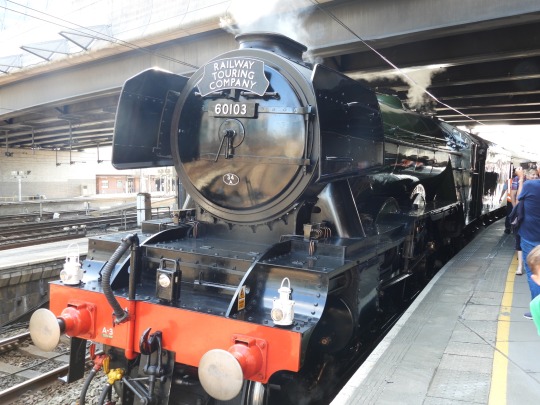
Built a century ago this year, No. 4472 - ahem, 60103 Flying Scotsman needs absolutely no introduction. Today she is the Kardashian of locomotives - she is famous for being famous. Unlike the Kardashians, that fame is well earned - namesake of the famed Flying Scotsman express, first non-stop run from London to Edinburgh in 1928, first (sort of) authenticated 100mph by a steam locomotive in 1934, one of the first privately preserved steam locomotives. She toured the United States (even though we don’t like to talk about how that one nearly ended) and Australia, making the longest non-stop run by a steam locomotive ever between Parkes and Broken Hill. To her detractors, she’s the ‘flying moneypit,’ bankrupting every owner since 1963. To her fans, she’s the most famous steam locomotive in the world, Sir Nigel Gresley’s masterpiece. And at long, long last, I have seen her in steam.
Basically, do you know how monarchists get really excited about seeing the King? This is my version of that.

After her departure at 9.40, I headed on the Circle Line to Sloane Square, walking through Chelsea and past the famed hospital there to the National Army Museum. The NAM is basically the cooler, hipper IWM, in my opinion. It perhaps benefits from a narrow subject matter; specifically Britain, and specifically the British Army. Without becoming too complicated, it does a much better job at contextualising its exhibits than the IWM, without shying away from the controversies and horrors of war. Do you think, for example, that the Australian War Memorial would stock a book about the massacre of Surafend, in the way the NAM stocks one on the British organised mass slaughter of Amritsar?
When I talk about museums, as you probably know by now, I like to mention an exhibit that struck me, and the exhibit in question at the NAM was more recent than you might expect. While I could discuss the saw that amputated the Earl of Uxbridge’s leg again - the fact that it still exists makes me very happy - I’ll instead mention a ruined L85 rifle from the Middle East, which was recovered from a vehicle destroyed by an IED - none of the passengers survived. Jay Winter has said that if one shows a weapon in a museum, they ought to show what it does. Here, in this ruined weapon, we see both at once. We don’t need to see the blood and bones of the soldiers; from this broken rifle, we can fill in the gaps as to the horrific power of explosives ourselves.
Also, the NAM cafe does a mean scrambled eggs.
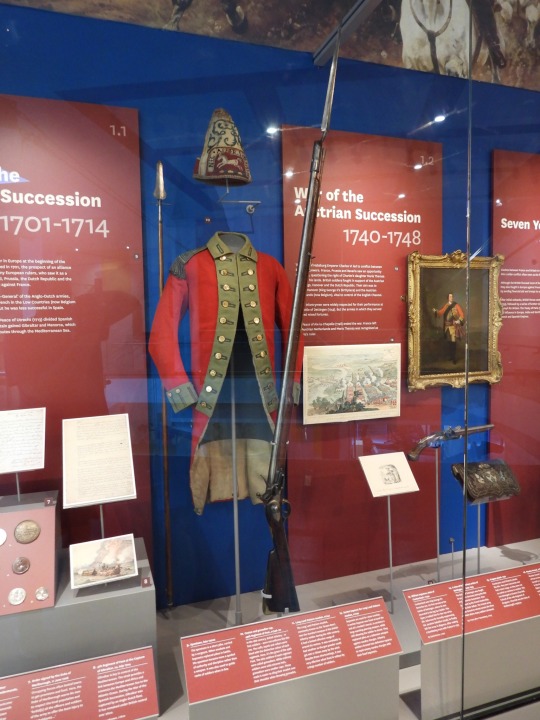
After the Army Museum, I headed back to the tube and caught the Circle Line again to St. James’ Park, where I walked to the Guards Museum. This is a small museum that people don’t really know about, and that surprises me as it’s literally right across the road from Buckingham Palace - it’s in Wellington Barracks, where the guards march from during the Changing of the Guard.
The Guards Museum is a very old-school and classic museum; a British Army regimental museum in the same old style that I love so very, very much. The museum is both wide in scope and intimate in subject matter - this isn’t the story of the army or the wars it fought, but the part played by the five regiments of the Foot Guards - the Grenadiers, the Coldstream, the Scots Guard, the Irish Guard and the Welsh Guard. For the majority of the British Army’s history, there were only the first three - oddly, the ‘1st’ (Grenadier) Foot Guards are actually the youngest, but as they were Charles II’s personal guard, they got to be senior after the Restoration in 1660.
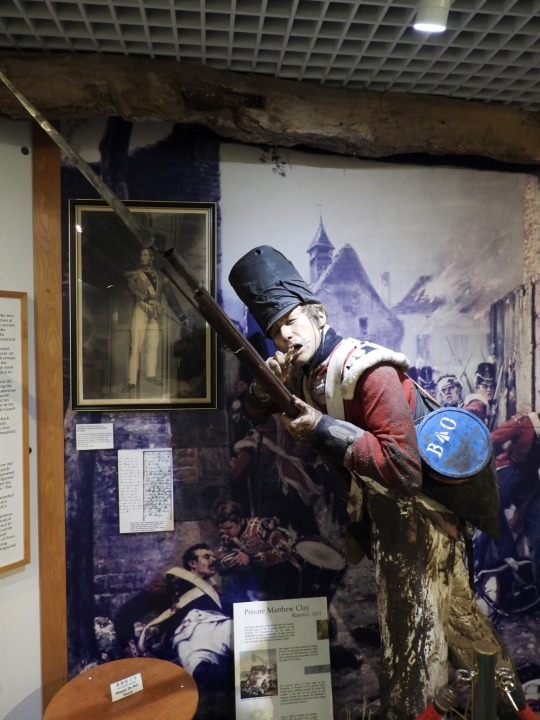
There were a lot of very interesting things in this museum, but I’m going to highlight something very boring instead. There’s a shako worn by a soldier of the Coldstream Guards in the late 1820s - it’s called a bell-top shako. Guards shakos from this period are very rare, because they were introduced in 1829 and dropped in 1831, when all of the Guards regiments adopted the bearskin cap of the Grenadiers. In fact, this shako was so rare that I didn’t actually know it existed - I’d assumed that the bearskins were adopted soon after Waterloo, but it seems the Coldstream and Scots Guards kept the shakoes of the regular infantry for just a little bit longer. This is a completely, utterly useless factoid, but I find it absolutely fascinating.
Across from the Guards Museum is the Guards Chapel, and to the uninitiated it looks strangely modern. Surely regiments as old as the Guards ought to have a similarly old chapel, right? Well, they did - until the morning of 18th June 1944, when it suffered a direct hit from a German V-1 flying bomb in the middle of a morning service. 121 were killed, and over 140 injured. The new chapel is not only a memorial to the men of the Household Division (the Foot Guards and the Household Cavalry), but to those killed in the bombing. I was initially the only visitor, and by the time I left only a small group of Americans - who I will say were very respectful - had joined me there. Dozens of regimental colours from throughout the Guards histories hang from the walls. I almost felt like an intruder in another family’s mausoleum.
I’m not religious, but for some reason I was moved to light a candle.
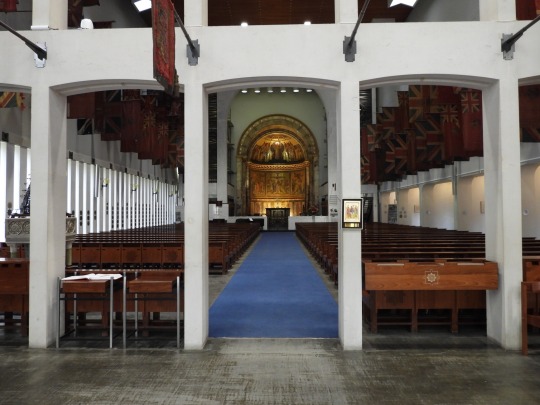
I walked from there, back past Buckingham Palace and down Lower Grovesnor Place, to a small memorial on the side of an intersection near Victoria. This is a curious little monument - it’s explicitly a memorial to the Great War, yet the Tommy on top is joined by a pair of riflemen from the Napoleonic and Crimean Wars respectively. This is the memorial to the Rifle Brigade, the progeny of the famed 95th Rifles of Wellington’s time (although a number of Rifle Brigade battalions could trace their heritage to the 60th Rifles as well.) After the Second World War, it was adapted to commemorate the riflemen lost in that conflict.
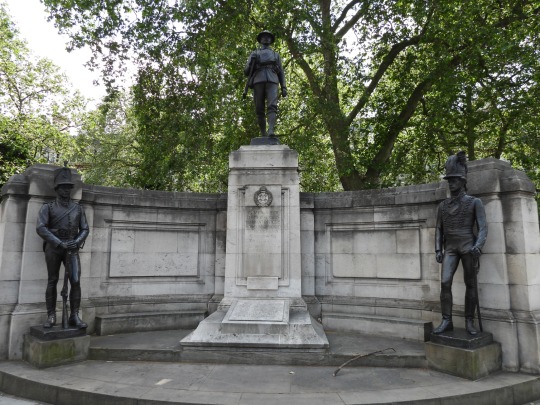
I visit a lot of memorials because I think they are interesting, or because I simply find them in the wild. I hunted down this one because it was important to me personally. This isn’t because I think the 95th were cool or because I watch a lot of Sharpe, or because green is my favourite colour and riflemen wore green uniforms. My nan had two uncles, one who fought in the First World War and one who fought in the Second. Both were riflemen - the first of the ‘Hackney Rifles’ and the second of the 7th Rifle Brigade. The first was wounded at Third Ypres, although I’m not certain how severely. The second still lies to this day in Florence, lost in the attacks on the Gothic Line in September 1944. It’s silly, and probably vulgar, but I’ve always seen the Rifle Brigade as ‘ours.’ I probably confused a lot of London commuters by pointing at a random monument in the middle of the city, repeating over again - ‘that’s us. That’s us.’
Yet it is us. The memory agents, the people who lived through the First World War, are all dead. The people who lived through the Second will still follow. It is now up to us to interpret their memory, their experiences, their histories and their stories. We have a responsibility to them.
Like it or not, this is us.
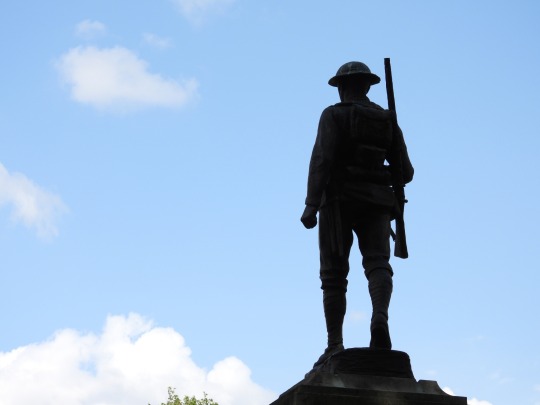
I then wrecked this profound emotional moment by having a big fanboy moment over a Routemaster bus, and then I walked back to the hotel. After a brief rest, I reunited with my mum and stepdad, who had been very kindly invited by my professor to join the group at the garden party of the Britain-Australia Society at the Royal Over-Seas League’s London HQ. It was all very sophisticated, with a lot of the great and good - and Joe Hockey - present, but I think it just didn’t quite gel with me. We stayed for a socially acceptable amount of time, then went back to Victoria Station and grabbed some McDonalds before parting.
We will reunite in Paris, but there’s a long road ahead to get there…
#flying scotsman#national army museum#guards museum#rifle brigade#first world war#second world war#napoleonic wars#crimean war
18 notes
·
View notes
Text
Darbar Of Khalsa..🙏🏻
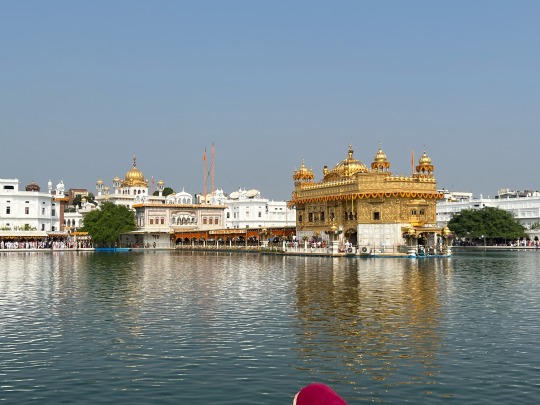
{Pictures by Prabhjot Kaur…}
Harminder Sahib or Darbar Sahib, a gurudwara located in Amritsar, Punjab, India. This is spiritually the most significant shrine in Sikhism.
For some people its just like any other Gurudwara, for some it’s just a tourist place, for some just a shrine, or its just a religious place, for some it’s a place to fill their stomach, for some its a place to stay, for some its place of full of life and people. But for me its not this, for me it’s different.
Being a child in Sikh family who belongs to Amritsar, the heart of Punjab, meaning of Darbar sahib is huge for me. It’s a place to refresh the soul, place where no one will judge you, where no one will ask you for your identity, you can sit anywhere in the Darbar Sahib and get inner peace. The premises of Darbar sahib consists of four doors in four directions which indicates that doors are open for everyone and everyone will be treated same way, no one is special or anything. This is the Highest place in Sikhism, where you’ll see everyone is praying, doing Path (reading holy scripts).
If someone asks me my favourite place? My answer is Darbar Sahib ‘cause it’s not just a place, it’s an emotion which can’t be described in words, you can only feel it. Whenever I visit the place, I get emotional. It seems like it’s the place where you can put your act of being which you do in front of the world and you can be original. The place is full of life, hope, patience, blessings, peace the inner peace and happiness. It’s not only a place of “Bhakti” but also a site of sacrifices which includes the blood of many Sikh’s and Shaheed’s, in which The Battle of Amritsar and operation Blue Star are included, in which more than thousand Sikhs became martyrs. According to Sikhism it’s a story of SABAR, SHUKAR, SIDAK, SIMARN DI MISAAL.
The Darbar sahib doesn’t only stand for religion but the Akaal Takht sahib (in front of Darbar sahib) stands for politics, in significance that religion can’t work without Politics and vice versa. It signifies the life of human, where we learn humanity, love, hope and equality. It’s the highest school of Sikhism.
If someone wants to know what is Sikhism? They should visit Darbar Sahib.
#amritsar#punjabi#punjab#sikhism#sikh#humanity#peace#peaceful#inner peace#photooftheday#photography#darbarsahib#trending#trends#religion#khalsa#goodtimeswithscar
5 notes
·
View notes
Photo

Mahatma Gandhi leaving the British viceroy’s residence in Simla, 1945 © Hulton-Deutsch Collection/Corbis/Getty Images
* * * *
India Against Ghandi :: A Legacy Rewritten Ramachandra Guha
India against Gandhi — a legacy rewritten Seventy-five years after his assassination, the ‘father of the nation’ is a problem for Narendra Modi — but the country still needs his ideas
Just as Russia now officially despises Sakharov, so Modi's India hates Gandhi and lauds the man who murdered him. Ramachandra Guha: Born in 1958, a decade after Gandhi’s death, I grew up in an atmosphere of veneration towards the Mahatma. One of my great-uncles helped to edit Gandhi’s Collected Works; another founded a pioneering initiative in community health inspired by Gandhi. These familial influences were consolidated and deepened by the public culture of the time. Gandhi was the father of the nation, the leader of the struggle for freedom against British rule, whose techniques of non-violent resistance had won admirers and imitators across the world. It was largely because of him that we were free and proudly independent, and it was largely because of him that — unlike neighbouring Pakistan — we gloried in the religious and linguistic diversity of our land. In our school assembly we sang a 17th-century hymn that Gandhi was particularly fond of, which he had rewritten to reflect his vision of the India he wished to leave behind.
Hindus saw God as Ishwar; Gandhi’s adaptation asked us to see him as Allah too. And it was to these lines that our teachers drew our particular attention.The first criticisms of Gandhi that I remember encountering were in a book I read as a student at Delhi University. This was the autobiography of Verrier Elwin, an Oxford scholar who became a leading ethnographer of the tribes of central India. Elwin knew Gandhi well, and at one time considered himself a disciple. In later years, while he retained his admiration for the Mahatma’s moral courage and religious pluralism, Elwin became sharply critical of Gandhi’s advocacy of prohibition, which he thought damaging to tribal culture (where home-brewed alcohol was both a source of nutrition and an aid to dance and music), and of his exaltation of celibacy, which Elwin thought damaging to everyone.
In Amritsar in 2006, members of the Congress party place garlands on a statue of Gandhi to mark the anniversary of his birth Elwin’s strictures were mild, even timid, when compared with those of the Marxist intellectuals of Kolkata, whom I encountered in the 1980s when beginning my academic career. These scholars identified with the Naxalites, a band of insurgents who were inspired by Mao Zedong and who vandalised and destroyed Gandhi statues wherever they found them. Books were written arguing that Gandhi was an agent simultaneously of the British colonial state and of the Indian capitalist class; non-violence was presented as a cunning device to wean the masses away from the revolutionary path.
I had many arguments with my Marxist friends about Gandhi. I sought to persuade them that his adherence to non-violence arose out of a disinclination to take human life. I asked them to give Gandhi at least the qualified praise that Mao himself had bestowed on Sun Yat-sen, the first president of the Chinese republic, as creating a rudimentary national consciousness on which was built a superior socialist consciousness. On these subjects my interlocutors at least talked back, but our relations came to breaking point when I chose to focus my own research on a forest protection movement led by Gandhians, which the Marxists dismissed as a bourgeois deviation from the class struggle.
Those debates with Marxists shaped me profoundly, personally as well as intellectually. Yet recalling them here perhaps conveys a whiff of antiquarianism. For now, in the 2020s, the main attacks on Gandhi in India come from the other end of the ideological spectrum. For the past eight and a half years, the Hindu right has been in power in India, and Gandhi’s philosophy of non-violence and his commitment to interfaith harmony are anathema to it. While he is still officially the “father of the nation”, with his birthday a national holiday and his face on the currency notes, the public mood has turned hostile to Gandhi.To understand why Gandhi is increasingly unpopular in his homeland, one must go back to the circumstances of his death 75 years ago. Gandhi was murdered on January 30 1948 by Nathuram Godse, a member of a secretive paramilitary organisation called the Rashtriya Swayamsevak Sangh. Founded in 1925, the RSS believed — and still believes — in the construction of a Hindu theocratic state in India. Its leaders and cadres insist that demographic superiority and the Indic origin of their faith makes Hindus natural and permanent rulers of the land. They have a particular suspicion of Muslims and Christians, on account of the fact that their religions originated outside India and their sacred shrines are outside India too.
[Financial Times] :: [h/t Scott Horton]
10 notes
·
View notes
Text
"For every trial and sorrow that God makes us shoulder, He has a reason." ~Khaled Hosseini.
A year has surpassed, since my anxiety disorder.
But even now, as the sun sways on the clouds at evenings, I can feel the remnants of the disorder. The anxiety penetrating deep within the edges of my belly, and the waves of the new-found atheism.
My disbelief in my God, Madhav.
I went to a couple of people for my anxiety. From the pathologist, to the school teachers, to the school counsellor, to friends, and lastly, to my aunt.
"Do yoga. Go meditate, it's good for anxiety,"
"You worry alot, and you overthink stuff. Why do you want to add more?"
"Itna tension nahi leneka. Be happy."
Imagine you're walking in a tunnel with a herd of people walking like sheeps. You're screaming; full throated cries. Yet, nobody in the tunnel can hear you. Yes, it feels exactly like that.
When the anxiety started, at cold dusks,
I would be on the brink of death.
Thoughts would nuzzle around my mind, like a snake caging its prey with its tail.
My hands would tremble and my breathing would occur with labour.
The fear, the stress, would slowly creep down to the belly of my abdomen and I could do nothing.
I had foreseen a panic attack.
I saw it coming.
Gently, it walked towards me in March.
One flaming hot summer noon,
In a caged toilet, with warm wind gushing through the windows, the attack began.
I remember traces; I was banging on the locked toilet door, with palms turned into fists, and I could not speak.
Words wouldn't fumble out of my mouth and I would helplessly bang on the oak door.
When I was released out of the toilet, the attack raced with a deadly speed.
My cheekbones, my lips, and my mouth went entirely numb. I can remember the tears flowing out of my eyes, and being incapable in providing life to my numb mouth.
"WHAT HAVE I DONE TO DESERVE ALL OF THIS? OUT OF ALL THE PEOPLE WHO COULD SUFFER, WHY ME? WHY ME?" I didn't realise I was screeching until my mother ran her fingers over the temple of my head, her eyes packed with tears.
I healed at the end of may, and the beginning of June.
After gazing at the monuments in Delhi, to the organized streets in Chandigarh, to the snow-capped mountains in Manali, to the flower gardens in Dalhousie, to the temple in Amritsar and lastly, with the soldiers at Wagha border.
With people, with places, and with memories,
I realised that life is now.
Life is in the present. Life is in the moment that I live, life is now that I'm writing.
Life is this.
My aunt, in east Maharashtra, was a messenger sent by Madhav, which we both believe in.
"You have taken the steering wheel of your life from Madhav. Return it back, divya. Let him drive. Let him take care of the speed and destination. You sit beside him and enjoy the journey. And trust him again. He won't let the brakes fail."
"It doesn't matter how many times you water a mango seed, for it will only ever bear fruits in summers."
"The only two things that you should focus on are; what you want in life and what will you do to achieve it."
She healed me.
At the end of the summer, on the brink of an upcoming monsoon,
In the garden, I met Madhav again.
In my dreams, I dream of peacock feathers and summers.
I dream that I am sitting beside the driver's seat and am gazing at the buildings that I grew up with.
"What happened?" Madhav asked.
I grinned; all teeth.
"Winters are parting," I answered.
"What do you see, Divya?" He asked standing beside me.
"I see the dawn of a rising sun."
"I will never let this sun set." He promised.
Now, as the fear of academic pressure looms over me, as new books, new publications await me,
I smile.
"Let me live now." i mutter.
I can see Madhav's eyes cramming with tears for the first time in days and a smile beaming at the dawn.
Author: Divya A. Korde.
8 notes
·
View notes
Text
Sugandha Mishra Wiki, Biography, Age, Height, Weight, Family, Net Worth

Sugandha Mishra Wiki: Sugandha Mishra is an Indian actress, playback singer, and TV host who is known for her funny roles on The Kapil Sharma Show and for the way she has hosted many TV shows and award ceremonies. Sugandha Mishra was born in Jalandhar, Punjab, on May 23, 1988, to parents Santosh and Savita Mishra. Sugandha's family has been a part of the Indore Gharana for four generations. Sugandha Mishra WikiBoyfriends, Affairs, Husband Favorite Things Her grandfather, Pandit Shankar Lal Mishra, taught her how to sing, and she has a doctorate in music from Guru Nanak Dev University in Amritsar. Sugandha's co-star on the show, Kapil Sharma, was a year ahead of her when she was getting her master's degree. Sugandha finished her schooling and moved to Mumbai, Maharashtra, where she lives and works now.

Sugandha Mishra Wiki, Biography
Sugandha Mishra Wiki
NameSugandha MishraBirth PlaceJalandhar, Punjab, IndiaDate Of Birth23 May 1984Age38 years (as of 2023)HeightIn centimeters – 165 cm In feet inches – 5’5”WeightIn Kilograms – 57 kg In Pounds – 127 lbsEye ColorBlackHair ColorBlackProfessionComedian, Playback Singer, AnchorSexual OrientationStraightSchoolRabindra Day Boarding Senior Secondary Public School, JalandharCollegeGuru Nanak Dev University, Amritsar Apeejay College of Fine Arts, JalandharReligionHinduismNationalityIndianHome TownJalandhar, Punjab, IndiaDebutTV: The Great Indian Laughter Challenge: Season 4 Film: Heropanti (2014) Song: “Zor Naache” and “Ishq Ki Dafli Baje”Fathers NameSantosh MishraMothers NameSavita MishraBrothersShivam MishraSisterAnkita (Elder) Boyfriends, Affairs, Husband BoyfriendsSanket Bhosale (Comedian & Doctor)Marital StatusMarriedHusbandSanket Bhosale (Comedian & Doctor) Favorite Things Favorite ActorsHrithik Roshan, Salman KhanFavorite ActressPriyanka Chopra, Sharmila TagoreFavorite FoodRajma-ChawalFavorite Singer(s)A.R. Rahman, Shankar Mahadevan, Shreya Ghoshal, Lata Mangeshkar, Asha BhosleFavorite SongMain Tenu Samjhawan KiFavorite Restaurant ChainBarbeque NationFavorite Color(s)Black Disclaimer: The above information is for general informational purposes only. All information on the Site is provided in good faith, however, we make no representation or warranty of any kind, express or implied, regarding the accuracy, adequacy, validity, reliability, availability, or completeness of any information on the Site. Read the full article
3 notes
·
View notes
Text
Best School in Amritsar: Ensuring Quality Education and Integrity
Ensuring quality education and maintaining integrity in academic assessments are paramount for the reputation of the best schools in Amritsar. With education being a cornerstone of personal and societal development, it is crucial to address systemic issues within the education system that contribute to incidents like paper leaks in competitive exams. Addressing these challenges can help institutions provide a fair and transparent learning environment for all students.
Systemic Issues Contributing to Paper Leaks
Administrative Lapses
One of the main reasons for paper leaks is administrative inefficiencies. Security breaches during the printing, transportation, and distribution of exam papers can lead to leaks. Institutions, including the best school in Amritsar and other top 10 schools in Amritsar, need more stringent protocols to ensure the integrity of these processes. Moreover, corruption and bribery within the administrative system can also lead to deliberate leaks of exam papers.
Pressure on Students and Educators
The immense pressure on students to perform well in competitive exams often drives them and their families to seek unfair advantages. Competitive exams are seen as the gateway to prestigious careers and higher education opportunities, creating a high-stakes environment. Schools and educators, evaluated based on the success rates of their students, might sometimes resort to unethical practices to ensure high performance.
Inadequate Supervision and Regulations
A lack of sufficient oversight from higher authorities and regulatory gaps can also contribute to paper leaks. Existing regulations might not be comprehensive enough to address all potential vulnerabilities in the exam administration process.
Impact on Education
Incidents of paper leaks undermine the credibility of the education system and affect the morale of honest students who compete fairly. This issue highlights the need for systemic reforms to enhance transparency, security, and fairness in the administration of competitive exams.
Potential Solutions
Enhanced Security Measures
Implementation of advanced security technologies such as encryption and secure logistics for handling exam papers can help prevent leaks. Additionally, biometric verification for individuals involved in the handling and distribution of exam materials can further enhance security.
Policy and Regulatory Reforms
Stricter penalties for those involved in paper leaks, including administrative officials, educators, and students, can deter unethical practices. Regular audits and inspections by independent bodies can ensure compliance with security protocols.
Reducing Pressure
Diversifying assessment methods to reduce the over-reliance on a single exam as the determinant of success can help mitigate the pressure on students. Providing a more holistic education that values continuous assessment and diverse talents can also be beneficial.
Relevance to Local Educational Institutions
The need for maintaining integrity in academic assessments is relevant to educational institutions across the country. For instance, the Millennium School in Patiala, Millennium School Indore, CBSE schools in Indore, schools in Kurukshetra, and the best school in Kurukshetra must prioritize transparency and ethical practices to maintain their reputations and provide fair opportunities to all students.
Ensuring Quality Education
Ensuring quality education involves not just academic excellence but also fostering an environment of integrity and fairness. The best schools in Amritsar, along with other top institutions like the Millennium School in Patiala and schools in Kurukshetra, play a pivotal role in setting high standards. These schools can implement robust security measures, embrace policy reforms, and reduce undue pressure on students to ensure a fair and transparent education system.
Conclusion
Addressing the systemic issues that contribute to paper leaks in competitive exams is essential for maintaining the integrity and reputation of the best schools in Amritsar and other top educational institutions. By implementing enhanced security measures, embracing policy reforms, and reducing pressure on students, schools can provide a fair and transparent learning environment that upholds the highest standards of education and integrity. This will ensure that all students have an equal opportunity to succeed based on merit, fostering a more just and equitable education system for future generations.
0 notes
Text
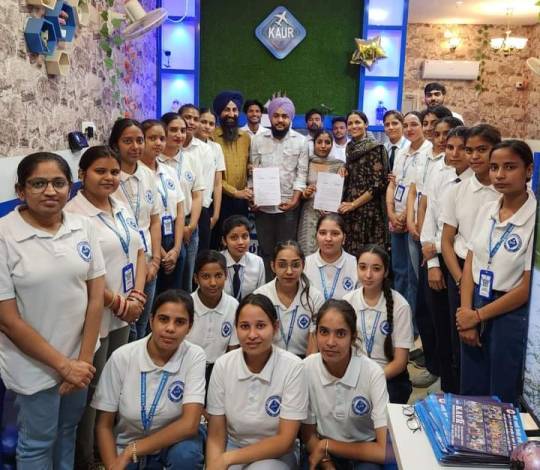
29 ਦਿਨ੍ਹਾਂ ‘ਚ ਆਇਆ ਕੋਮਲਪ੍ਰੀਤ ਕੌਰ ਅਤੇ ਉਸਦੇ ਪਤੀ ਗੁਰਸੇਵਕ ਸਿੰਘ ਵਾਸੀ ਪਿੰਡ ਲੋਧੜ੍ਹਾਂ, ਜ਼ਿਲ੍ਹਾ ਫ਼ਿਰੋਜ਼ਪੁਰ ਦੋਹਾਂ ਦਾ ਇਕੱਠਿਆਂ ਦਾ ਕੈਨੇਡਾ ਦਾ ਵੀਜ਼ਾ ਕੋਮਲਪ੍ਰੀਤ ਕੌਰ ਨੂੰ ਮਿਲਿਆ ਸਟੂਡੈਂਟ ਵੀਜ਼ਾ ਤੇ ਗੁਰਸੇਵਕ ਸਿੰਘ ਨੂੰ ਮਿਲਿਆ ਸਪਾਊਸ ਵੀਜ਼ਾ ਮੋਗਾ:- ਕੋਮਲਪ੍ਰੀਤ ਕੌਰ ਅਤੇ ਉਸਦੇ ਪਤੀ ਗੁਰਸੇਵਕ ਸਿੰਘ (ਨੂੰਹ ਤੇ ਪੁੱਤਰ ਜਸਪਾਲ ਸਿੰਘ ਅਤੇ ਪਰਮਜੀਤ ਕੌਰ) ਵਾਸੀ ਪਿੰਡ ਲੋਧੜ੍ਹਾਂ, ਜ਼ਿਲ੍ਹਾ ਫ਼ਿਰੋਜ਼ਪੁਰ ਦੋਹਾਂ ਦਾ ਇਕੱਠਿਆਂ ਦਾ ਕੈਨੇਡਾ ਦਾ ਸਟੂਡੈਂਟ ਤੇ ਸਪਾਊਸ ਵੀਜ਼ਾ ਮਨਜ਼ੂਰ ਹੋਇਆ ਹੈ। ਕੋਮਲਪ੍ਰੀਤ ਕੌਰ ਨੂੰ ਸਟੂਡੈਂਟ ਵੀਜ਼ਾ ਮਿਲਿਆ ਹੈ ਜਦਕਿ ਪਤੀ ਗੁਰਸੇਵਕ ਸਿੰਘ ਨੂੰ ਸਪਾਊਸ ਵੀਜ਼ਾ ਮਿਲਿਆ ਹੈ। ਸਾਡੀ ਟੀਮ ਨੇ ਕੋਮਲਪ੍ਰੀਤ ਕੌਰ ਅਤੇ ਉਸਦੇ ਪਤੀ ਗੁਰਸੇਵਕ ਸਿੰਘ ਦੀ ਇਕੱਠਿਆਂ ਦੀ ਫਾਈਲ 23 ਮਾਰਚ 2023 ਨੂੰ ਲਗਾਈ ਗਈ ਸੀ ‘ਤੇ 20 ਅਪ੍ਰੈਲ 2023 ਨੂੰ ਵੀਜ਼ਾ ਆ ਗਿਆ । ਕੋਮਲਪ੍ਰੀਤ ਕੌਰ ਕੈਨੇਡਾ ਦੇ ਸ਼ਹਿਰ Vancouver ਵਿੱਚ ਪੜ੍ਹਨ ਕਰਨ ਜਾ ਰਹੀ ਹੈ। ਕੋਮਲਪ੍ਰੀਤ ਕੌਰ ਨੇ 2020 B.A. ਕੀਤੀ ਸੀ। ਕੋਮਲਪ੍ਰੀਤ ਕੌਰ ਦੇ ਓਵਰਆਲ 6.5 (L-7.0, R-6.5, W-6.5, S-6.5) ਬੈਂਡ ਹਨ । ਕੋਮਲਪ੍ਰੀਤ ਕੌਰ ਉਸਦੇ ਪਤੀ ਗੁਰਸੇਵਕ ਸਿੰਘ ਨੇ 2019 ‘ਚ B.A. ਪਾਸ ਕੀਤੀ ਸੀ । ਕੌਰ ਇੰਮੀਗ੍ਰੇਸ਼ਨ ਦੀ ਟੀਮ ਵੱਲੋਂ ਕੋਮਲਪ੍ਰੀਤ ਕੌਰ ਅਤੇ ਉਸਦੇ ਪਤੀ ਗੁਰਸੇਵਕ ਸਿੰਘ ਵਾਹਵਾ ਸਾਰੀਆਂ ਵਧਾਈਆਂ ।
ਜੇਕਰਤੁਸੀਂਵੀ
ਸਟੱਡੀ ਵੀਜ਼ਾ ‘ਤੇ ਕੈਨੇਡਾ ਜਾਣਾ ਚਾਹੁੰਦੇ ਹੋ! ਜਾਂ
ਸਟੂਡੈਂਟ ਤੇ ਸਪਾਊਸ ਦਾ ਇਕੱਠਿਆਂ ਦਾ ਕੈਨੇਡਾ ਦਾ ਵੀਜ਼ਾ ਲਗਾਉਣਾ ਚਾਹੁੰਦੇ ਹੋ ਜਾਂ ਫਿਰ
ਤੁਹਾਡਾ ਸਪਾਊਸ ਕੈਨੇਡਾ ਪੜ੍ਹ ਰਿਹਾ ਹੈ ਜਾਂ ਵਰਕ ਪਰਮਿਟ 'ਤੇ ਹੈ ਅਤੇ ਤੁਸੀਂ ਵੀ ਸਪਾਊਸ ਵੀਜ਼ਾ ‘ਤੇ ਕੈਨੇਡਾ ਜਾਣਾ ਚਾਹੁੰਦੇ ਹੋ ਜਾਂ ਫਿਰ
ਸਟੂਡੈਂਟ ਦਾ ਵੀਜ਼ਾ ਆ ਗਿਆ ਹੈ ਤੇ ਸਪਾਊਸ ਨੂੰ ਨਾਲ ਹੀ ਲਿਜਾਣਾ ਚਾਹੁੰਦ��� ਹੋ!
ਕੈਨੇਡਾ ‘ਚ ਆਪਣਾ ਕਾਲਜ ਬਦਲਣਾ ਚਾਹੁੰਦੇ ਹੋ|
ਯੂ.ਕੇ. ਜਾਂ ਆਸਟ੍ਰੇਲੀਆ ਸਟੂਡੈਂਟ ਵੀਜ਼ੇ ਜਾਂ ਸਟੂਡੈਂਟ+ਸਪਾਊਸ ਵੀਜ਼ੇ ‘ਤੇ ਜਾਣਾ ਚਾਹੁੰਦੇ ਹੋ। ਤਾਂ ਅੱਜ ਹੀ ਕੌਰ ਇੰਮੀਗ੍ਰੇਸ਼ਨ ਨੂੰ ਮਿਲੋ ਜਾਂ ਹੁਣੇ ਵੱਟਸਐਪ ਕਰੋ ਆਪਣੇ documents ਜਾਂ ਕਾਲ ਕਰੋ: ਮੋਗਾ ਬਰਾਂਚ:- 96926-00084 96927-00084 96928-00084
ਅੰਮ੍ਰਿਤਸਰ ਬਰਾਂਚ: 96923-00084 :93553-00084 ਮੋਗਾ ਬਰਾਂਚ: Old Allahabad Bank Market , Near Majestic Chowk , Main Bazar , Moga ਅੰਮ੍ਰਿਤਸਰ ਬਰਾਂਚ: SCO 41, Veer Enclave , Near Golden Gate and Ryan International School, Bypass Road, Amritsar
studyincanada #studyabroad #CanadaImmigration #studyinvancouver #studentrecruitment #kaurimmigrationservices #studentspousevisacanadatogether #spousevisa #studypermitcanada
2 notes
·
View notes
Text
Best Properties to Buy in Lucknow - Your Dream Home Awaits

Introduction
Lucknow, the city of Nawabs, is emerging as one of the most sought-after real estate destinations in India. With its rich history, vibrant culture, and rapid urbanization, Lucknow offers an excellent blend of tradition and modernity. Whether you're a first-time buyer or an experienced investor, choosing the best property for buy in Lucknow can be a game-changer for your financial portfolio and lifestyle. In this comprehensive guide, we will explore the finest residential and commercial properties that the city has to offer, along with essential tips to help you make an informed decision.
Why Invest in Lucknow's Real Estate Market?
Lucknow's real estate market is booming due to its strategic location, connectivity, and government initiatives aimed at improving infrastructure. The city has become a hub for education, healthcare, and information technology, attracting a diverse population. With the new metro lines, flyovers, and smart city projects, Lucknow is evolving at an unprecedented pace, making it a lucrative location for property investment.
Rapid Infrastructure Development
One of the key factors driving property demand in Lucknow is its robust infrastructure development. The Lucknow Metro, Outer Ring Road, and Amritsar-Kolkata Industrial Corridor have significantly improved connectivity within and outside the city. Additionally, Lucknow's proximity to cities like Delhi, Kanpur, and Varanasi makes it a prime spot for real estate growth.
Growing Job Market and Educational Institutions
The increasing number of IT parks, business hubs, and MNCs setting up offices in Lucknow is creating a growing demand for both residential and commercial properties. Moreover, the presence of prestigious educational institutions such as IIM Lucknow and Dr. Ram Manohar Lohia National Law University adds to the city's appeal for families looking to settle here.
Top Residential Areas to Buy Property in Lucknow
When it comes to buying a home, Lucknow has a wide array of options ranging from affordable housing projects to luxurious villas. Below are some of the top residential areas that cater to different budgets and preferences.
1. Gomti Nagar
Gomti Nagar is one of the most sought-after localities in Lucknow. It is known for its well-planned infrastructure, wide roads, green parks, and proximity to commercial hubs. The area is home to numerous luxury apartments, villas, and independent houses. With schools, hospitals, and malls in close vicinity, Gomti Nagar offers a well-rounded lifestyle for families.
Price Range: ₹5,000 - ₹10,000 per sq. ft.
Amenities: Close to Gomti Riverfront, International Cricket Stadium, Malls, and Top Educational Institutions.
2. Hazratganj
For those who prefer to live in the heart of the city, Hazratganjis the perfect location. Famous for its historical significance and bustling markets, Hazratganj offers a mix of modern apartments and heritage homes. This area is ideal for those looking for a premium lifestyle with easy access to shopping, dining, and entertainment options.
Price Range: ₹10,000 - ₹15,000 per sq. ft.
Amenities: Proximity to historical landmarks, luxury hotels, and high-end shopping complexes.
3. Sushant Golf City
For buyers seeking a luxury lifestyle in a serene environment, Sushant Golf City is a top choice. This integrated township offers a world-class golf course, luxury villas, and premium apartments. With wide open spaces, top-notch security, and all modern amenities, Sushant Golf City is perfect for those who want to enjoy a tranquil yet luxurious life.
Price Range: ₹6,000 - ₹12,000 per sq. ft.
Amenities: Golf Course, High-End Restaurants, Premium Schools, and Hospitals.
4. Aliganj
Aliganj is a well-established residential area with a mix of independent houses and apartments. It is popular among families due to its proximity to schools, hospitals, and markets. The area offers a good balance between affordability and quality of life, making it ideal for middle-class families looking to invest in their dream home.
Price Range: ₹4,000 - ₹8,000 per sq. ft.
Amenities: Markets, Educational Institutes, and Healthcare Facilities.
5. Indira Nagar
Indira Nagar is another prominent residential locality known for its affordable housing options. It has a well-developed infrastructure with wide roads, parks, and easy access to public transportation. If you're looking for a budget-friendly home that offers good value for money, Indira Nagar should be on your list.
Price Range: ₹3,500 - ₹6,500 per sq. ft.
Amenities: Shopping Centers, Schools, Parks, and Hospitals.
Commercial Real Estate: Opportunities in Lucknow
While residential properties offer comfort and stability, commercial real estate in Lucknow provides an excellent opportunity for generating passive income or establishing your business. The city's growing economy and business-friendly policies make it an attractive market for commercial property investors.
1. Gomti Nagar Extension
Gomti Nagar Extension is rapidly becoming the go-to destination for commercial investment in Lucknow. With multiple IT parks, office spaces, and retail outlets, this area offers high returns on investment. The proximity to residential areas makes it a perfect spot for businesses looking to cater to local communities.
Price Range: ₹6,000 - ₹12,000 per sq. ft.
Best For: IT companies, retail stores, and office spaces.
2. Shaheed Path
Shaheed Path is another upcoming commercial hub with excellent connectivity to the rest of the city. This area is attracting major commercial projects, including shopping malls, multiplexes, and corporate offices. If you're looking for a high-growth area to invest in commercial property, Shaheed Path should be your top consideration.
Price Range: ₹7,000 - ₹14,000 per sq. ft.
Best For: Shopping complexes, business parks, and entertainment centers.
Factors to Consider When Buying Property in Lucknow
Investing in real estate is a significant financial decision, and it's crucial to evaluate various factors before making your purchase. Here are some essential points to keep in mind when buying property in Lucknow:
1. Location
The location of the property plays a critical role in determining its future value. Areas with good connectivity, proximity to educational institutions, healthcare facilities, and shopping centers tend to appreciate faster.
2. Infrastructure and Amenities
When choosing a property, ensure that the locality has a well-developed infrastructure, including wide roads, parks, and reliable public transport. Amenities such as 24x7 security, power backup, and water supply are essential for a comfortable living experience.
3. Legal Documentation
Before finalizing your purchase, verify all legal documents, including the title deed, land-use certificates, and NOCs from relevant authorities. It is advisable to consult a legal expert to ensure that the property is free from any disputes.
4. Builder's Reputation
If you're buying a property from a developer, research their track record in terms of project delivery, quality of construction, and customer reviews. A reliable builder ensures peace of mind and guarantees the timely completion of the project.
Conclusion: Best Property for Buy in Lucknow
Lucknow offers a wide variety of properties that cater to different needs, whether you're looking for a luxury villa in Gomti Nagar or an affordable apartment in Indira Nagar. With its growing infrastructure, booming job market, and rich cultural heritage, the city is an excellent location for real estate investment.
0 notes
Text
Boys Hockey Tournament: Army Boys Sports Company, SGPC, and Don Bosco School Excel in Quarterfinals
Pune, 10th October 2024: Defending champs Army Boys Sports Company, former 2022 champions Shiromani Gurdwara Parbandhak Committee (SGPC), Amritsar, Don Bosco School made it to the quarterfinals in contrasting fashion in the 8th SNBP All India Boys (Under-16) Hockey Tournament at the Shiv Chhatrapati Sports Complex, Balewadi-Mhalunge on Thursday. The day however was a bad day out for host’s SNBP…
0 notes